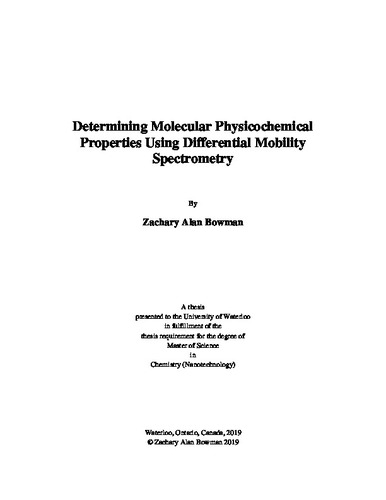| dc.contributor.author | Bowman, Zachary | |
| dc.date.accessioned | 2019-09-26 17:40:51 (GMT) | |
| dc.date.available | 2019-09-26 17:40:51 (GMT) | |
| dc.date.issued | 2019-09-26 | |
| dc.date.submitted | 2019-09-16 | |
| dc.identifier.uri | http://hdl.handle.net/10012/15173 | |
| dc.description.abstract | This thesis aims to explore the usage of differential mobility spectrometry (DMS) and quantum chemical calculations to separate and identify drug compounds, as well as the use of machine learning (ML) to predict physicochemical properties such as the collision cross section (CCS) and single solvent binding energies (BEs) using experimental DMS data. Chapter 3 shows the ability of DMS to separate derivatized amphetamines and methamphetamine isomers and uses calculated BEs to identify the separated isomers by their DMS behavior. Chapter 4 demonstrates the separation of (+)-ephedrine and (+)-pseudoephedrine as well as three groups of sulfonamide isomers using a variety of gas modifiers within the DMS. CCS are used to describe behavior in pure N2 gas, while BEs are used to predict the ordering of the separation voltage at the compensation voltage minima (SV at CVmin) values within different isomeric groups. By making use of data gathered by Walker et al.1 ML models were generated for prediction of CCS as well as H2O and MeOH BEs and tested using the isomers studied in this chapter. In order to demonstrate the need for the model to train on similar compounds to those being tested, several of the test compounds were moved into the training set of the ML model and the change in predictivity observed. In the final chapter of this work, chapter 5, the CCS ML database was expanded using a sizable number of compounds with varied structure and functionalities in order to increase the predictivity of the ML model for new compounds. The effectiveness of incorporating additional compounds was evaluated by the creation of learning curves for the ML training and test sets. These projects ultimately show the capability of DMS in making separations of isomeric compounds, as well as its potential for use in the prediction of CCSs and BEs through ML modelling. | en |
| dc.language.iso | en | en |
| dc.publisher | University of Waterloo | en |
| dc.subject | differential mobility spectrometry | en |
| dc.subject | machine learning | en |
| dc.subject | ion-solvent binding energy | en |
| dc.subject | collision cross section | en |
| dc.title | Determining Molecular Physicochemical Properties Using Differential Mobility Spectrometry | en |
| dc.type | Master Thesis | en |
| dc.pending | false | |
| uws-etd.degree.department | Chemistry | en |
| uws-etd.degree.discipline | Chemistry (Nanotechnology) | en |
| uws-etd.degree.grantor | University of Waterloo | en |
| uws-etd.degree | Master of Science | en |
| uws.contributor.advisor | Hopkins, W. Scott | |
| uws.contributor.affiliation1 | Faculty of Science | en |
| uws.published.city | Waterloo | en |
| uws.published.country | Canada | en |
| uws.published.province | Ontario | en |
| uws.typeOfResource | Text | en |
| uws.peerReviewStatus | Unreviewed | en |
| uws.scholarLevel | Graduate | en |

